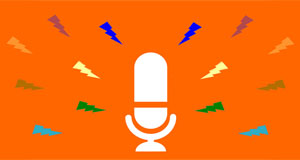PodCASTing in the Classroom
Combine Creativity, Audio, Storytelling and Technology to improve student learning

Podcasting is a powerful tool for sharing audio, or video, information online with family, community and the world. The term podcast originates from iPod and broadcast, hence the term podcast.
Students love a non-traditional approach to learning and listening to a podcast. While not that different from listening to a lecture, listening to a podcast still provides a connection to the contemporary world that is often missing in the traditional classroom. Podcasts are a great way to hook students as you introduce a new topic or lesson or to reinforce or extend what has already been taught.
While there are benefits to using podcasts to support instruction, they are even more powerful when students create them and give their knowledge, ideas, and expertise a voice!
Benefits of student-created podcasts
Engages learners in content
Producing a podcast provides a motivating opportunity for students to showcase their knowledge, skills, and creativity, while at the same time requiring deep thinking about the curriculum as they do the research and writing necessary to complete the podcast.
Improves literacy skills
Learning to read, write, listen and speak are critical skills for students of all ages. Podcasting provides an opportunity to practice and develop all of these skills in an authentic context.
Builds essential life skills
Producing a podcast not only requires content knowledge and academic communication skills, it requires collaboration, project management, leadership, media literacy, and more. These "soft" skills are essential for success in life beyond the classroom.
Amplifies student voice
Publishing a podcast online gives voice to student knowledge and stories in within the community and in the world at large. This broad platform can motivate them to do the hard work necessary, while giving them the opportunity to experience advocacy for themselves and the issues they care about.
Gives impact to student work
While students can create podcasts that are only relevant to their academic classes, the easy access to and public nature of a typical podcast makes it powerful tools to connect what is learned in the classroom to the world beyond it.
Choose the type or topic for your podcast
With the rapid changes in technology, the definition of podcasting has expanded to mean any series of audio or video files from a single producer or on a single topic. If you are a school media or instructional technology specialist, a recurring podcast with different topics about your school or community may be a good idea for a class or club.
If you are a subject-area teacher, a series of podcasts centered around a topic you are studying may work better. For example, your students could create podcasts that:
- narrate a historical event like a women's suffrage march.
- share step-by-step instructions others can use to gain new skills.
- inform others or express an opinion about a contemporary issue.
- share historic or scientific information about a place in your community.
Before getting started, hook your students with a few great content-specific podcasts in a style you wish them to emulate. If you teach science, try Wow in the World. If you teach history, listen to an episode of Stuff you Missed in History Class, and if you teach language arts, listen to an episode of the student-created The Unexplainable Disappearance of Mars Patel.
Producing a podcast is not an individual assignment. Whether you work in teams or as an entire class, success will hinge on teamwork. Form teams of students that include varying levels of expertise, ability, and skills to foster positive interdependence. You may also want to assign specific roles to solidify the value of each member's contribution, as well as help students meet all project requirements.
Give structure to student work
Podcasts don't happen without research, planning, and teamwork. Recording and/or creating the final podcast or vodcast can only happen after extensive research, planning, writing, and editing. Set students up for success by clearly outlining the steps they will need to take to produce a successful podcast within an estimated time period.
Make sure students understand that quality research and writing is essential to success. Once a topic is chosen, students should decide what "angle" they want to take to explore and share information. This will help focus the research and/or interview questions they will ask as they work to build a foundation of content knowledge they will pull from to write their podcast.
The key to classroom success will be in the planning. Students should create an outline or storyboard to highlight key ideas they have discovered in their research. This provides you with a check-in point to evaluate:
- the amount and quality of their research and content knowledge.
- misconceptions they may not have undercovered.
- analysis of the relative importance of different pieces of content.
- ability to organize information for a compelling narrative.
While you will want to review their plan before they start writing the script or structuring dialogue, this is also a great time for a formal peer feedback and review process. Even if you are working as an entire class, take a moment to restate the big ideas and details of the plan with an opportunity, and expectation, for feedback. This helps promote both a growth mindset and cements a culture where students take responsibility for their own learning as well as the learning of the entire class.
The next step is to translate research and outline into a compelling narrative. To build writing skills for all students, ask each student to write a first attempt. Then, have them share their work with the team to identify strengths and build upon each other's ideas as they combine, develop and extend individual ideas into a team script.
Create the podcast
There are many "correct" tools and options for creating podcasts. It is easiest to get permission and support if you choose a tool already installed on your site's computers.
If you want an audio only file, Audacity is a free tool commonly used to record and edit audio files. If you are creating a vodcast, or video podcast, any tool that can export an .MP4 file, such as Wixie, iMovie, or Video Editor will work.
If you are creating a series of episodes, ask for volunteers to come after school, or task students that finish early with designing and producing a trailer to advertise your work at the beginning of each episode.
Share the podcast
Distributing a single audio or video file is easy, but the options get a bit more complex if you want to create and share a podcast series.
If you have the ability to add audio and video files to your classroom web page, that is perhaps the easiest place to begin. If permitted by your site, you can also upload videos to a video-sharing site like YouTube. Your school may also have a Facebook social media where you can share.
If you want to get really professional, ask your site technical staff about an RSS feed. RSS, or Really Simple Syndication, allows users to access content on a web page that is regularly updated. This may require setting up an account at a site like RSS.com.
It's time to get started
Because humans connect to (and remember) stories, researching, writing and producing a podcast is a great way to connect students to the content they are learning in school. Podcasting in the classroom is also a powerful way to motivate learners to do the research, writing, and communication practice necessary for literacy-building for today's world.












